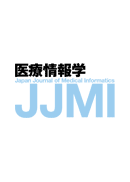All issues

Volume 35 (2015)
- Issue 6 Pages 259-
- Issue 5 Pages 199-
- Issue 4 Pages 151-
- Issue 3 Pages 99-
- Issue 2 Pages 55-
- Issue 1 Pages 3-
Volume 35, Issue 4
Displaying 1-4 of 4 articles from this issue
- |<
- <
- 1
- >
- >|
Original Article-Notes
-
T Zaima, J Murakami, K Miura, A Sugano, Y Takaoka, I Morisaki2015 Volume 35 Issue 4 Pages 151-156
Published: 2015
Released on J-STAGE: October 21, 2016
JOURNAL FREE ACCESSProvision of the medical information for the person with the visual impairment is one of the problems about the reduction of the information gap. Most of information about the dental practice are provided to the patient in a document, and it is difficult for the person with the visual impairment to read and understand an explanation document righted by visible characters. “Law for Elimination of Disability Discrimination” is established, and it is expected that realization of “reasonable accommodation” in the law is demanded. Therefore, construction of the information support system in dentistry to the people with the visual impairments is urgent need. Here we report a case made it possible to build a system that can be provided by Braille and a figure about the dental information and operate conveniently.View full abstractDownload PDF (1176K) -
S Doi, H Ide, T Inoue, Y Kitayama, A Nishide, T Nakamura, S Fujita, T ...2015 Volume 35 Issue 4 Pages 157-166
Published: 2015
Released on J-STAGE: October 21, 2016
JOURNAL FREE ACCESSThe Patient Access Area Model (PAAM) is a technique used to evaluate the balance of future medical demand and supply in small areas, simulating patients' access to hospitals using a geographic information system (GIS). In this study, we changed the value of several parameters of the PAAM―such as patients' travel time for each hospital, number of hospitalization days, availability of hospital beds, and rate of treatment accepters―in order to investigate how to prevent the over-demand of healthcare. When we assumed hospital bed availability to be 80%, which is the same as the current status, it was predicted that over 77,000 inpatients would not receive inpatient care in the Tokyo metropolitan area in 2030. However, this number would decrease if we lowered the rate of treatment accepters by 10% and the number of hospitalization days. Using this model, recommendations can be made regarding what action should be undertaken and by when to prevent a dramatic increase in healthcare demand. This method can help plan geographical resource allocation in medical services for healthcare policy.View full abstractDownload PDF (2126K)
Interest Material
-
H Watanabe, M Kimura, K Kawaguchi, K Ohe2015 Volume 35 Issue 4 Pages 167-175
Published: 2015
Released on J-STAGE: October 21, 2016
JOURNAL FREE ACCESSThis study explored the functions and actual use of hospital healthcare information system for each hospital. Questionnaire was based triennial “Commonwealth Fund International Health Policy Survey of Primary Care Physicians”. The institutions which can create patient's list in some given conditions was about 60-70 percent. In the hospital, an introductory rate of “Notification for the patient by IT system” was low. The e-mail system at the medical-examination was seldom used.View full abstractDownload PDF (1222K) -
H Watanabe, M Kimura, K Kawaguchi, K Ohe2015 Volume 35 Issue 4 Pages 177-187
Published: 2015
Released on J-STAGE: October 21, 2016
JOURNAL FREE ACCESSThe range of the clinical information of referral documents was explored by questionnaire. Less than three months of prescription history and blood sample test result by patient referral was peak. Less than 1year of image information was peak.
Most doctors answered there is no need to re-examine same blood test in their institute when they had information since less than half month. Less than half-month~one-month of image information was peak.View full abstractDownload PDF (2145K)
- |<
- <
- 1
- >
- >|